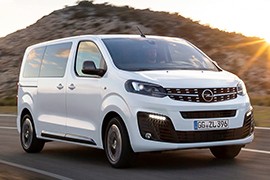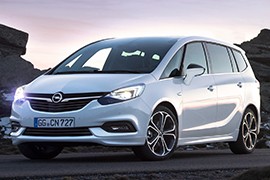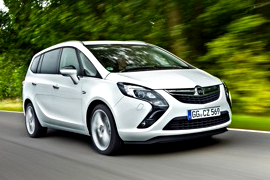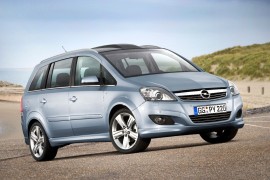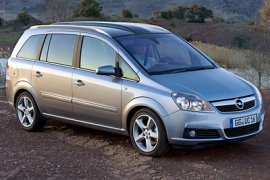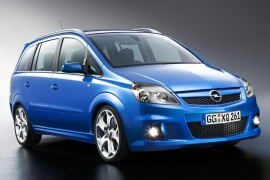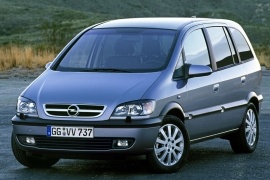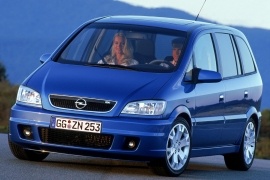OPEL Zafira Models/Series Timeline, Specifications & Photos
First production year: 1999
Engines: Diesel, Natural gas, Gasoline, Hybrid
Body style: Van
Opel introduced the Zafira Life MPV in its lineup in 2019 as a full-size people carrier that could transport eight people comfortably over long distances, plus a lot of luggage in the back.
After joining the PSA Group (Peugeot-Citroen) in 2017, Opel also gained access to some of the French automaker’s platforms and products. As a result, it introduced the Zafira Life MPV into the growing D-segment people carrier vehicles. Previously, the German automaker used the Zafira nameplate for C-segment minivans developed onto compact-sized platforms. Unlike those vehicles, built in three generations between 1999 and 2019, the Zafira Life sat on the EMP2 base gained from PSA. The French automaker used it to create other vehicles, such as the Peugeot Traveler or the Citroen Expert. In addition, since creating an MPV wasn’t cheap, and the market wasn’t high for these kinds of vehicles, it shared it with Fiat, which made the Ulysse, and Toyota, which created the Proace.
Badge engineering was simple for Peugeot-Citroen since they already had experience in doing that. The French automaker knew that the front fascia was the most significant brand image, allowing Opel to create a unique design for the Zafira Life. As a result, the car sported swept-back headlights with integrated, L-shaped LED daytime running lights. Between them, the grille sported a horizontal chromed line that stretched from side to side and supported Opel’s big logo that took center stage. Furthermore, the automaker added chromed details, making the vehicle look more upscale.
The automaker installed functional venting areas on the lower bumper that helped cool the engine and the big AC condenser. The lower grille was flanked by side scoops that sported additional LED daytime running lights and the optional fog lamps. As a last detail, a lip spoiler adorned the bottom of the apron. The Zafira Life was available in three lengths and two wheelbase versions. Its flat and tall front doors featured black door mirrors, with an option for body-colored ones and an electric folding function. Customers could also get the Zafira with two powered sliding doors that helped with the ingress and egress. Finally, at the back, the automaker installed a broad tailgate flanked by the taillights.
Inside, the Zafira Life offered room for up to nine passengers, regardless of the vehicle’s length, since European laws required a special driving license for cars with more than that number of seats. At the front, it was obvious that the car was related to a utility vehicle. Its plastic dashboard was tall, and the center stack housed the gear stick or the rotary knob for the automatic transmission, depending on the options. The high-mounted seats were comfortable for long distances. The Zafira Life offered several configurations in the back, with bench seats or captain seats. The automaker also offered the option for glass roof areas for improved interior illumination.
Under the hood, Opel installed a choice of three turbo diesel engines paired with either a six-speed manual or an eight-speed automatic. All versions were fitted with front-wheel drive systems.
The third generation of the Zafira was introduced in 2011 at the Geneva Motor Show. In 2016, it went through a facelift.
The MPV market was shrinking more and more, making room for the SUV market that was growing day by day. But the GM still believed in the minivans, and that's why they continued to offer a spacious, suitable for seven passengers. It was based on the same platform as the Astra J, and, at the time of its launch, it was Britain's most favorite 7-seat vehicle.
The facelift brought new headlights, which lost the boomerang light, and a new grille resembled the one found on the Insignia. The front bumper was redesigned as well and received a sportier look, even if we were talking about a minivan, which is in total opposition with a sporty car.
Inside, few options started to be included as standard. The infotainment system with a touch-screen on top of the center stack was installed in from the base version. It gathered a few of the previously used buttons that cluttered the area. There were 13 storage compartments in the Zafira, but the glove-box was a small one.
Opel offered the Zafira with a choice of one gasoline and two diesel options, mated to either a manual or an automatic gearbox. Unfortunately, it wasn't offered as a hybrid.
The 2011 Zafira, also known as the Tourer C, was based on the same platform with the Opel/Vauxhall Astra J. It was unveiled at the Frankfurt Motor Show.
The first generation of the Zafira was unveiled in 1999 and it was an MPV based on the successful compact vehicle Astra. Its 7-seat capability and the car-like handling made it a top seller on the market. It was a time when the minivan market was at its peak.
The third generation of the Zafira went further and took the design cues from the Insignia. The swept-back headlights were parts of a boomerang-style light unit with the fog-lights on the bottom. The chromed bar on the narrow grille was already a trademark for the German minivan. The raked A-pillars were complemented by an additional B-pillar forming a triangular side-front window. The roof was slightly sloped to the back and a big and flat tailgate ended the car. The sculptured side panels and doors gave a flowing-line to the car.
Inside, there was room for seven passengers. The tall seats and comfortable layout made the Zafira Tourer C an excellent car for long journeys, especially if it was fitted with the right engines. The dials and the instrument cluster resembled those found in the Astra J. The infotainment system was mounted on the center stack and it offered connectivity with Android Auto and Apple CarPlay.
Under the hood, the Zafira C was offered with a choice of gasoline, diesel, and two gas engines. The latter ones were very useful for fleet vehicles and were mated to a 6-speed manual only. All of the others were available with manual or automatic transmission.
OPEL Zafira Tourer 1.4L Turbo 6AT FWD (140 HP)
OPEL Zafira Tourer 1.4L Turbo 6MT FWD (120 HP)
OPEL Zafira Tourer 1.4L Turbo 6MT FWD (120 HP) Start & Stop
OPEL Zafira Tourer 1.4L Turbo 6MT FWD (140 HP)
OPEL Zafira Tourer 1.4L Turbo 6MT FWD (140 HP) Start & Stop
OPEL Zafira Tourer 1.6L SIDI Turbo 6AT FWD (170 HP)
OPEL Zafira Tourer 1.6L SIDI Turbo 6MT FWD (170 HP)
OPEL Zafira Tourer 1.6L SIDI Turbo 6MT FWD (200 HP)
OPEL Zafira Tourer 1.6L CDTI ecoFlex 6MT FWD (120 HP)
OPEL Zafira Tourer 1.6L CDTI ecoFlex 6MT FWD (136 HP)
OPEL Zafira Tourer 2.0L BiTurbo CDti 6MT FWD (195 HP)
OPEL Zafira Tourer 2.0L CDTI 6AT FWD (130 HP)
OPEL Zafira Tourer 2.0L CDTI 6AT FWD (165 HP)
OPEL Zafira Tourer 2.0L CDTI 6MT FWD (110 HP)
OPEL Zafira Tourer 2.0L CDTI 6MT FWD (130 HP)
OPEL Zafira Tourer 2.0L CDTI 6MT FWD (130 HP) Start & Stop
OPEL Zafira Tourer 2.0L CDTI 6MT FWD (165 HP)
OPEL Zafira Tourer 2.0L CDTI ecoFlex 6AT FWD (170 HP)
Opel was caught on the wrong foot when it introduced the Zafira in 2008. GM, the parent company, already knew that the world economic crisis would hit the automotive industry hard. Yet, even though the new generation was just two years old, it tried its luck and introduced a facelift for it.
Minivans were almost a dead option for most carmakers. On the other hand, Opel was keen on producing them in two sizes: the Corsa-based Meriva and the Astra-based Zafira. But customers started to dig deep in their pockets for many things, but not cars. As a result, the car industry suffered, and Opel was on the brink of extinction. A Russian company tried to buy Opel from GM, but the American carmaker dropped that offer at the last moment.
Opel added a new pair of headlights and a revised grille with the facelifted version that showed the chromed badge in the middle. Above it, a chromed horizontal slat adorned and completed the front-fascia image. Some additional chromed trims adorned the car's exterior depending on the trim level. At the same time, the clear-lenses taillights provided a better image for the minivan at the back.
As expected, the 2008 Zafira provided more than enough room for five passengers inside. The raised seating position for all five occupants gave them more legroom, and thanks to the tall greenhouse, the headroom was not an issue either. Yet the dashboard and the instrument panel were somehow carried over from the Astra.
Under the hood, the carmaker had to cope with new emission regulations standards in Europe. That means that most of them were highly fuel-efficient. In addition, a 2.0-liter turbocharged unit that provided 200 ponies was added to the spec's list for those who were in a hurry.
Opel introduced the second generation of the compact-sized Zafira MPV on the European market, even though the minivan segment was declining.
Like its predecessor, the second generation of the Zafira was based on the Astra's platform. Thus, GM could lower the vehicle's production costs and still provide a decent quality car. Thanks to that, the compact-sized minivan was a hit among the rental companies, which were an important segment for Opel.
GM's European design department used the same lines on the Astra H lineup for the new generation. Its clear ellipsoid headlights followed the new-edge design language. The front fascia featured a new grille adorned with a chromed slat at the top, which also included the Opel's badge. On the sides, the carmaker added a set of body-colored moldings, thus protecting the metal parts from small bumps in the parking lot. At the back, the vertical tailgate was extended downward into the bumper, thus creating a low loading area.
Inside, the cabin provided enough room for up to seven passengers on three rows of seats, with the last row folding flat in the trunk. At the front, the high-mounted seats provided good all-around visibility. The instrument cluster featured only the speedometer, tachometer, and fuel level in the instrument panel, losing the coolant-temperature gauge. In addition, the carmaker installed the infotainment system atop the center stack.
Under the hood, the carmaker introduced a choice of six engines, both gasoline and turbo-diesel, paired with either a five- or six-speed manual or a six-speed automatic.
The Opel Zafira OPC was improved in 2005 in terms of exterior design active safety equipment.
Developed by Opel’s Performance Centre, the minivan was hard to beat in its class by other rivals.
The new model came with more power produced by a new 2.0-liter turbocharged gasoline engine. The unit developed 240 hp and was mated with a 6-speed manual transmission that sent power to the front wheels. With a maximum torque of 320 Nm at 2,4000 rpm, the powerful minivan could accelerate to 100 kph/h in 7.8 seconds.
Aesthetically, the OPC featured a deep front spoiler with a large central engine cooling air-intake. The 18-inch 6-spoke design alloys were specifically designed for the OPC. The aggressive design was enhanced with the accentuated side sills and the powerful-looking rear fitted with trapezoidal tailpipes.
While the Arden Blue was the specific exterior paint color, customers had other 3 options: start silver, sapphire black, and magma red.
Inside, the cabin featured high-quality materials. Opel installed Recaro sport-bucket seats that were available in two different versions. Besides the leather-wrapped steering wheel and the leather-covered gear lever, the sporty look was completed by the aluminum pedals.
Besides the sporty nature, the minivan was an efficient one, offering seating for 7. Equipped with the patented Flex-7 seating system, the Zafira could easily be transformed into a 6,5,4,3, or 2-seater.
Safety-wise, the OPC was equipped with ESP, Continuous Damping Control, and various brake functions. To further enhance the sporty feeling, the SportSwitch mode could be selected for a firmer chassis set-up.
Opel introduced a final refresh for its first-generation Zafira MPV in 2003, before completely change the model in 2005.
When General Motors used its minivan experience from the U.S. soil, it created one of the best compact minivans from the European market. Unlike the Renault Espace, it offered a seven-seat interior in a compact segment length. On top of that, it shared most of its underpinnings with its stablemate Astra, leading to a lower total cost of ownership. With the 2003 model, Opel brought a breath of fresh air into the lineup.
At the front, the car featured new, clear headlights with a bolder look and a darkened upper area. Its bumper sported a broad grille at the bottom, which incorporated the side-mounted fog lights. Since the carmaker already knew its customers, it kept the black, unpainted moldings around the bodywork and the wheel-arches to avoid costly repairs for parking scratches.
Inside, the 2003 Zafira received a more extended instrument cluster extended above the center stack. It resembled the one from the Vectra and included the onboard computer screen. The carmaker introduced an option for a new CD player mounted above the climate-control dials. In the back, there were not too many changes apart from upholstery options. There were still three seats in the middle row and another two on the folding jump-seats from the trunk.
Under the hood, the carmaker offered a range of three gasoline and two turbo-diesel units paired either with a five-speed manual or a four-speed automatic, depending on the engine.
Opel introduced the Zafira MPV in 1997 based on the same platform as the Astra and, four years later, it dared to offer it in a more spirited version and became the quickest minivan on the European market.
Usually, the minivans are those people-carriers blocking the left lane (or the right ones for RHD) and dropping the children in front of their schools. The Zafira OPC was different. It was a grown-up hot-hatch able to carry seven people inside, but it could keep up with sporty sedans from its times.
The Zafira OPC sported a slightly different front fascia than the rest of the range. The carmaker installed a unique bumper with a broad grille at the bottom to cool the intercooler. A pair of side-scoops hosted the fog lights and helped to cool the front brakes. Its hood-grille sported a black slat on top, with the OPC lettering on it. Apart from the 17" light-alloy wheels, there were no obvious signs of its performances from its sides.
Inside, the carmaker was not that subtle anymore. Inside the instrument cluster, Opel placed white dials and two small LCDs for the onboard computer. The seats were different than on the rest of the Zafira range. For the front ones, they featured higher bolstering. It was a tall car with high-mounted seats, but the occupants still had to stay in their places during high-speed cornering. In the back, apart from the specific upholstery, Opel installed the same seats as on the rest of the Zafira range.
Under the hood, the carmaker installed a 2.0-liter turbocharged gasoline engine. It wasn't exactly a usual powerplant for a minivan, but Opel did it, and it paired it exclusively with a five-speed manual gearbox. The stiffer suspension with thicker anti-roll bars helped in the handling department.
Opel decided to enter the European compact MPV segment and produced the Zafira lineup base on the same platform as the Astra G.
In 1999 there were just two minivans on the market in the compact segment: the Renault Megane Scenic and the Citroen Xsara Picasso, but none of them offered an option for seven seats. Opel seized that moment and introduced the Zafira, which was the first seven-seat MPV built on top of a car platform. Volkswagen and Mercedes-Benz already had some minivans, but they based them on light-utility vehicle platforms.
Since the Astra was already well-known on the market, Opel took that advantage and used a similar front fascia for the Zafira. It shared the same headlights and grille, even though the hood was steeper, and it sported a different bumper with a wider grille at the bottom. From its sides, the Zafira looked like a taller station wagon. Its black rubber strips from the beltline and bumpers protected it from minor scratches in parking lots.
Zafira's main advantage was the interior. The design team made it long enough to fit three seat rows inside with room for seven people. There was not too much trunk space with all the seats up, but it was as big as a light commercial vehicle with the second and third rows folded. Holden spoiled the driver with a car-like dashboard carried over from the Astra but with a taller center stack and higher seating position.
Opel installed a choice of six engines under the Zafira's hood, both gasoline and turbo-diesel. Later on, Opel introduced a sportier version named Zafira OPC, with a turbocharged two-liter engine under the hood.
